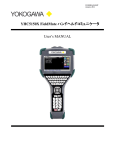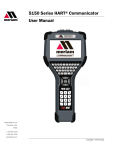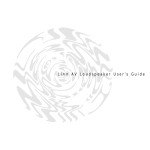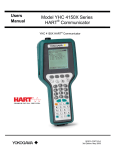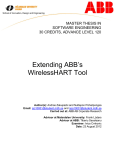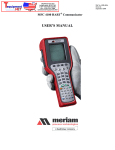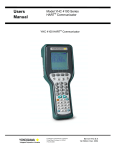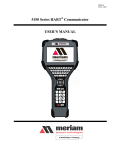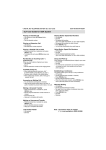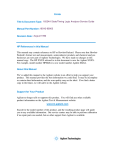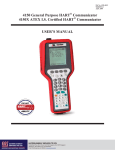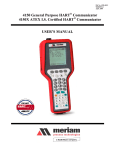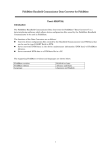Download YHC5150X FieldMate Handheld Communicator User`s Manual
Transcript
IM 01R01A30-01EN-B November, 2014 V 1.3 YHC5150X FieldMate Handheld Communicator User’s Manual YHC5150X FieldMate: User’s Manual Page 1 Safety Information Preventing injury Failure to follow all instructions could result in injury: Read. Understand. Follow all safety warnings and instructions provided with this product. Meet or exceed your employer’s safety practices. Not liable In no event shall Yokogawa be liable for any indirect, special, incidental, consequential, or punitive damages or for any lost profits arising out of or relating to any services provided by Yokogawa or its affiliates. It is not possible for Yokogawa to identify all foreseeable uses or misuses, therefore all persons involved in commissioning, using, or maintaining this product must satisfy their self that each intended application is acceptable. Safety Symbols The following table defines the safety symbols, signal words, and corresponding safety messages used in the manual. These symbols: Safety Symbols Identify potential hazards. Warn you about hazards that could result in personal injury or equipment damage. Explaining the symbols This is the Read Instruction Manual symbol. This symbol indicates that you must read the instruction manual. This is the Safety Alert symbol. This symbol indicates a WARNING. Warnings alert you to actions that can cause personal injury or pose a physical threat. Please read these carefully. This is the Safety Glasses symbol. This symbol indicates that you must wear approved safety glasses during the task. This is the Safety Gloves symbol. This symbol indicates that you must wear approved safety gloves during the task. Indicates a potentially hazardous situation which, if not avoided, will result in death or serious injury. Indicates a potentially hazardous situation which, if not avoided, could result in death or serious injury. Indicates a potentially hazardous situation which, if not avoided, could result in minor or moderate injury. Indicates information essential for proper product installation, operation or maintenance. YHC5150X FieldMate: User’s Manual Page 2 ATEX Documentation The information on the following two pages only applies to countries in the European Union. GB SK DK CZ I LT E LV NL EST SF PL YHC5150X FieldMate: User’s Manual Page 3 ATEX Documentation (continued) P SLO F H D BG S RO GR M YHC5150X FieldMate: User’s Manual Page 4 Contents Safety Information ....................................................................................................................... 2 ATEX Documentation.................................................................................................................. 3 ATEX Documentation (continued) .................................................................................. 4 Contents ..................................................................................................................................... 5 Trademarks................................................................................................................................. 8 Yokogawa Contact Information ................................................................................................... 9 Definitions for Terminology ....................................................................................................... 10 Definitions for terminology (continued)...........................................................................11 Definitions for terminology (continued)...........................................................................12 Installing or removing the battery pack ...................................................................................... 13 Charging the battery pack..............................................................................................14 Memory System Card ....................................................................................................14 Memory System Card (continued) .................................................................................15 YHC5150X Series HART Communicator Overview ................................................................... 15 Overview (continued).....................................................................................................16 Keyboards – touchscreen and dedicated .................................................................................. 17 Touchscreen – System menus ......................................................................................17 Touchscreen – HART menus ........................................................................................18 YHC5150X Operating Instructions ............................................................................................ 19 Power key functions ......................................................................................................19 Backlight—reducing intensity.........................................................................................20 Backlight—settings for timeout ......................................................................................21 Standby—settings for timeout ........................................................................................22 Timeout—Backlight and Standby are cumulative ...........................................................23 The battery pack life ......................................................................................................23 The battery pack life (continued)....................................................................................24 The charging cradle .......................................................................................................25 The charging cradle (continued) ....................................................................................26 Kickstand—useful for viewing the display ......................................................................26 Loop Communication Jacks & Field-wiring practices .....................................................27 Keyboard overview ........................................................................................................28 Keyboard functions ........................................................................................................29 YHC5150X FieldMate: User’s Manual Page 5 Keyboard functions (continued) .....................................................................................30 Keyboard – the on-screen keyboard ..............................................................................30 Keyboard – the on-screen keyboard ..............................................................................31 Limited character sets ...................................................................................................32 Limited number of characters ........................................................................................33 Navigating in the screen ................................................................................................33 Navigating the keysets ..................................................................................................34 Touchscreen – Keyset #1 ..............................................................................................34 Touchscreen – Keysets #2-5 .........................................................................................35 Navigating the Communicator .......................................................................................36 Navigating the Communicator (continued) .....................................................................37 HART navigation and connection status ................................................................................... 38 HART connection status ................................................................................................39 HART list of found HART devices ..................................................................................40 Main system menus .................................................................................................................. 41 System Setup Menu ......................................................................................................42 Date/Time Setup – System menu ..................................................................................43 Power Setup – System Menu ........................................................................................44 Language Selection – System Menu .............................................................................45 Language Selection – Displayed ...................................................................................46 Language Selection – Displayed (continued) .................................................................47 Calibrating the touchscreen– System Menu ..................................................................47 System Information – System Menu ..............................................................................48 HART Setup Menu .................................................................................................................... 49 Shifting the highlight in HART menus ............................................................................50 Shifting the highlight in HART menus (continued) ..........................................................51 Status Line for the connecting device ............................................................................52 DD files control HART menus ........................................................................................53 Function buttons in HART menus ..................................................................................54 Function buttons: Explaining the buttons .......................................................................55 Function buttons: More buttons .....................................................................................56 Creating Shortcuts .........................................................................................................57 Creating Shortcuts: Invalid shortcuts .............................................................................58 HART menu path bar.....................................................................................................58 YHC5150X FieldMate: User’s Manual Page 6 Advanced Tools for HART: Two Option buttons ............................................................59 Advanced Tools for HART: DD Browser ........................................................................60 Advanced Tools for HART: View device names and revisions .......................................61 Advanced Tools for HART: Offline Configuration ...........................................................62 Advanced Tools for HART: Offline Configuration ...........................................................63 Advanced Tools for HART: Waiting for the Offline Configuration ...................................64 Advanced Tools for HART: Indicators in Offline Configuration .......................................65 Advanced Tools for HART: Function buttons .................................................................66 HART Communication with the YHC5150X Series.................................................................... 67 Connecting the YHC5150X to Smart Transmitters with HART technology .....................68 Loop resistance > 250 Ω ...............................................................................................69 Polling: HART Communication ......................................................................................70 Polling: HART Communication (continued) ....................................................................71 Specific and Generic HART communication ..................................................................72 Managing Configuration Files ........................................................................................73 Managing Configuration Files (continued) .....................................................................74 Managing Configuration Files (continued) .....................................................................75 Managing Configuration Files (continued) .....................................................................76 Troubleshooting HART Communications .......................................................................77 Troubleshooting HART Communications (continued) ....................................................78 Updating communicator software ..................................................................................78 Hazardous area use ......................................................................................................79 Hazardous area - Warnings & Cautions.........................................................................80 Returning for repair........................................................................................................81 Appendices ............................................................................................................................... 82 Product Specifications ...................................................................................................82 Safety notices ................................................................................................................83 Waste Electrical and Electronic Equipment (WEEE), Directive 2002/96/EC ..................84 Spare parts list ..............................................................................................................85 Intrinsic Safety Control Drawing.....................................................................................86 YHC5150X FieldMate: User’s Manual Page 7 Trademarks HART Communication Foundation HART® and HART Communication Foundation are used by permission of the HART® Communication Foundation. YHC5150X FieldMate: User’s Manual Page 8 Yokogawa Contact Information For customer Assistance Address Yokogawa Corporation of America 2 Dart Road Newnan, GA. 30265USA Telephone 1-800-888-6400 E-mail [email protected] Website www.yokogawa.com/us Information in this document is subject to change without notice. Check the Yokogawa web site for latest manual revision: http://www.yokogawa.com/us/products/field-instruments/ia-smartcommunicators/yhc5150x.htm HART Communication Foundation HART website For more information regarding the HART Communication Foundation topics, go to www.hartcomm.org YHC5150X FieldMate: User’s Manual Page 9 Definitions for Terminology Terminology Definitions Button or key A button always refers to an area on the screen that you can tap to select functionality. A key always refers to hardware push-buttons on the keyboard that you can press. Manufacturers create HART® compliant Device Description (DD) files that reside on the YHC5150X. You may need to check for updates to the DD files from time to time. DD or Device Description files DD files “provide a standardized method for host systems to access and display valuable parameters located in field instruments so that the full capability of the device can be accessed via the HART protocol.” DDs are “used to describe such parameters as device diagnostics, multi-variable measurements and device configuration information in a digital format. As applied in the HART Protocol, this digital information is imposed on top of the industry-standard, process control 4-20mA signal.” Note: The two italicized statements come from the HART Communication Foundation’s web site: http://en.hartcomm.org/hcp/tech/dd/aboutprotocol_dds.html Highlight This manual uses the word highlight in two ways: 1. As a noun: highlight refers to an icon or a menu line that has the focus on-screen at any given time. 2. As a verb: highlight refers to: a. Pressing the arrow keys or Advance key to change the focus to a new button. b. Pressing and holding a button on-screen for one second to change the focus to a new button. YHC5150X FieldMate: User’s Manual Page 10 Definitions for terminology (continued) Terminology Definitions Highlights appear in three colors: red, gray, and yellow. A red rectangle appears in: o System menus. A gray highlight appears in: o The HART Navigation pane. A yellow border appears in: o Selection boxes when an item is selected. o The HART Function button pane. o The HART menu path bar. Highlight colors YHC5150X FieldMate: User’s Manual Page 11 Definitions for terminology (continued) Terminology Definitions This manual uses the word select to refer to: Navigating the levels of menus in the communicator. Opening additional screens: o To navigate the communicator’s menu levels. o To view information. o To view additional functions. Performing some task on the communicator. Note: Highlight an on-screen button you want to choose and select it. You may select items by using one of several methods: Navigation numbers Select Navigation shortcuts Touchscreen gestures as you do on a smartphone, such as: o Tapping on-screen buttons or icons. o Swiping left or right. o Scrolling up or down. Navigation keys use: o The Arrows and Advance/Switch buttons to highlight a button. o The Select button to select the highlighted button. Numeric keys: o 1-9 and 0, minus and decimal. o These Navigation shortcuts select the function directly. A combination of touchscreen gestures and keys. Note: The Spacebar is used as a shortcut key only on system menus. Since it is directly above the Navigation keys, it offers an easy way to select the connection bar. Standby or sleep This manual uses the word standby mode to describe putting the communicator into an energy-saving mode, where it uses very little power. Some use the word sleep mode instead of standby. YHC5150X FieldMate: User’s Manual Page 12 Installing or removing the battery pack Installing the battery To install the battery pack: 1. Set the communicator enclosure with the display downward on a flat, stable surface. 2. Rest the battery pack in the battery pack compartment of the enclosure. 3. Leave a ½ in. gap (or 1.27 cm) between the battery pack and the connector on the communicator enclosure. 4. Slide the battery pack inside the enclosure until the connectors mate completely and the screws align with the threaded inserts on the communicator body. Note: Two standard 6-32 screws hold the battery pack in the communicator. These screws are a part of the battery pack. They have hexagonal sockets that require a 7/64 in. hex key wrench. 5. Thread the screws into the inserts to complete the installation. Note: The 7/16 in. hex key wrench is included with the unit. Don’t over tighten Do not over tighten the screws when you install the battery pack. Over tightening screws can cause damage the communicator. Note: Maximum torque should not exceed seven (7) in-lb. (or 0.79 N-m). Removing the battery Reverse the order of the steps in the Installing a battery section above. 6-32 screws with 7/16 in. hexagonal socket µSD memory card access YHC5150X FieldMate: User’s Manual Page 13 Charging the battery pack Charge 10 hours Charge the battery completely for 10 hours before first use. See the sections about The charging cradle for more detail. Memory System Card Uses for the memory card The communicator is shipped with a µSD memory system card. This system card is necessary for the following uses: Storage of required software. Software updates. HART DD files. Device configuration files. Use only with the YHC5150X The µSD memory system card is not intended for use unrelated to the operation of the communicator. The YHC5150X Series System card must be installed to operate the communicator. Note: While the µSD memory system card is in the YHC5150X, there is no way to access the card except with the Yokogawa provided computer software. Replace with Yokogawa 1W-9P780 If you need to replace the µSD card, it must be replaced with part number 1W-9P780 or the successor part number specified by Yokogawa. Replace the card only under the direction of Yokogawa personnel. Use of a non-system memory card voids the Intrinsic Safety Compliance. Installing & removing battery pack To remove and to replace the memory system card you must remove the battery first. See the Installing or removing the battery pack section for more details. Removing the memory card Once you have removed the battery pack: 1. Press gently on the memory card to unlock it from the cardholder. 2. Carefully remove the memory card from the enclosure. Note: Tweezers or small needle-nose pliers can be helpful in removing and inserting memory cards - apply gentle pressure only. YHC5150X FieldMate: User’s Manual Page 14 Memory System Card (continued) Replacing the Memory Card Once you have removed the memory system card: 1. Insert the new memory card carefully into the cardholder. Verify the contacts are facing toward the back of the communicator and card label facing towards the front (screen side) of the communicator. 2. Be sure the memory card is resting in the holder before releasing it. 3. Gently press the card into the holder to lock it into place. 4. Install the battery pack and secure it to the communicator enclosure. YHC5150X Series HART Communicator Overview Full function HART The YHC5150X Series HART Communicator is a full function HART Communicator supporting HART communication: Universal. Common Practice. Device Specific commands. Note: These commands allow you to commission, configure, and maintain operations. YHC5150X FieldMate: User’s Manual Page 15 Overview (continued) Diagram of the YHC5150X YHC5150X FieldMate: User’s Manual Page 16 Keyboards – touchscreen and dedicated Touchscreen – System menus Touchscreen - Display details The communicator has a 4.3-in. (10.9 cm) widescreen, backlit, TFT color touchscreen display: It has a 480 x 272 WQVGA pixel resolution. The entire viewable area of the screen is an active touch surface. The touchscreen responds to and is optimized for finger presses - even when you are wearing gloves. Important: No stylus is necessary. Never tap the screen with sharp objects – simply use your finger. Touchscreen - Two menu systems The communicator displays two types of menus: System menus. HART menus. Touchscreen - System menu The system menu displays after you press the Power key. You can switch to the system menu from any HART menu. There are three distinct areas on the system menus: The top of the menu provides system information. The middle of the menu contains navigation icons to system actions or new system menus. The bottom of the menu contains current HART connection status and navigation buttons. System Information System Navigation Focus Pane HART Connection and Navigation Sample system display YHC5150X FieldMate: User’s Manual Page 17 Touchscreen – HART menus HART menus appear when connected to HART devices The HART menus are only available when a HART communication enabled device is connected and communicating with the communicator. There are four distinct areas on a HART menu: The top of the menu provides information on the currently attached device as well as various status indicators. The middle of the menu is divided into two functional areas: o HART Menu navigation o Function buttons. The bottom of the menu contains the HART Menu Path bar. Sample HART menu display Device and Status Line HART Navigation Menu Function Buttons HART Menu Path bar YHC5150X FieldMate: User’s Manual Page 18 YHC5150X Operating Instructions Power key functions Turn on When you press and hold the Power key for two seconds, the communicator launches a complete system start sequence: The first screen displays the FieldMate logo. The second screen displays a white screen with a list of drivers loading. The third screen displays the date and time. Now the communicator is ready to use. Standby When you press the Power key and release, the communicator enters the standby mode (sometimes referred to as sleep mode): The screen is off and the communicator ignores most user input to conserve battery power. The on-board computer maintains the previous system state of functionality to resume quickly. Do not use the standby mode as a substitute for turning off the unit for extended periods of time. Resume When you press the Power key and release, the communicator quickly resumes operation from being in Standby: It returns to the exact state of functionality that it was in before entering standby. From the Power Setup Menu, users can enter a specific time for the unit to automatically enter the standby mode to conserve battery power. Turn off When you hold the Power key until the screen turns off, the communicator is turned off: We recommend turning off the communicator as the best way to conserve battery life. Note: The batteries will lose some power while not in use. For this reason, we recommend keeping the communicator in the charging cradle when not in use. YHC5150X FieldMate: User’s Manual Page 19 Backlight—reducing intensity Pressing the Backlight key The Backlight key allows you to choose one of five levels of intensity: 20%, 40%, 60%, 80%, and 100% brightness. You can press the Backlight key while on any screen. Press the Backlight key and release it to display the current percent of backlight in use. Press it again within two seconds to change the intensity level to the next level. Continue to press it to set the intensity level you want. Reducing intensity improves battery life The following table presents the estimated savings using the various backlight levels. Backlight intensity at: 20% 40% 60% 80% YHC5150X FieldMate: User’s Manual While the communicator is on, the battery life is improved by: Up to 80% Up to 50% Up to 30% Up to 12% Page 20 Backlight—settings for timeout Changing the timeout setting to save battery life By default, the Backlight is set to never timeout. The never timeout setting can reduce your battery’s life. You can change the setting to reduce the backlight intensity to 10% after 30 seconds, 1, 2, 3, 4, 5, or 10 minutes. Tap the screen or press a key to return to the previous level of intensity. Navigating to the timeout settings From the Main System screen: 1. Select the System Setup icon. 2. Select the Power Management icon. 3. Select the Backlight timeout settings icon. YHC5150X FieldMate: User’s Manual Page 21 Standby—settings for timeout Change the timeout settings to save battery life By default, the communicator is set to never timeout. The never setting can reduce your battery’s life. You can choose to configure the setting to automatically enter standby mode after being inactive for 3, 4, 5, 10, or 15 minutes. Select the Standby timeout settings icon to change the timeout setting. Navigating to the Standby timeout settings From the Main System screen: 1. Select the System Setup icon. 2. Select the Power Management icon. 3. Select the Standby timeout settings icon. See the following screen shot. YHC5150X FieldMate: User’s Manual Page 22 Timeout—Backlight and Standby are cumulative An example of the cumulative timeouts The Standby timeout period does not start until the Backlight period has timed out. To determine the amount of time before a communicator automatically enters Standby mode, you must add the timeout settings for Backlight and Standby together. If… Then… You set the Backlight timeout to 30 seconds You set the Standby timeout to 3 minutes After the communicator is out of the cradle and it has no input for 30 seconds, The communicator reduces the intensity to 10%. 3 minutes and 30 seconds after the start of the Backlight timeout, The communicator enters Standby mode. The battery pack life Keep charging it We strongly recommend putting the communicator in the charging cradle whenever you are not using it. This is the easiest way: To conserve battery life. To increase the overall number of battery charge cycles. YHC5150X in the charging cradle YHC5150X FieldMate: User’s Manual Page 23 The battery pack life (continued) For portable use A rechargeable lithium-ion battery pack powers the communicator for portable use. A fully-charged battery typically allows for: 10 hours of continuous operation. 40 hours while in the standby mode. Note: See the section for Installing or removing the battery pack. Note: Order part number 1W-9A820-1 from Yokogawa to replace the battery pack. Advanced battery fuel gauge The battery pack contains an advanced battery fuel gauge that actively monitors the battery capacity. It, therefore, does not require any battery conditioning throughout the life of the battery. YHC5150X FieldMate: User’s Manual Page 24 The charging cradle Cradle connection details Look at the back of the cradle: Power connection to AC adapter USB connection to computer Automatically recharges Each communicator includes a charging cradle and power adapter. The cradle automatically recharges the lithium-ion battery when the communicator is properly inserted into it. Note: To fully recharge a depleted battery takes about six hours. Charging indicator There is a multicolor LED on the front of the charging cradle. This LED indicates the current charging mode. Charging LED indicator light Light Status Off Solid Green Flashing Amber Solid Amber Flashing Red Solid Red Indicates… The communicator has not been correctly inserted or the power is disconnected. The battery is fully recharged. The battery is charging. The battery temperature is out of the charging range. The charging process has been suspended. There is a battery fault. There is a charging fault. Connecting to a computer You need to connect the USB cable to the charging cradle and to a computer to update files. The communicator must be in the cradle and turned on to update files. Note: See the section for Updating communicator software. YHC5150X FieldMate: User’s Manual Page 25 The charging cradle (continued) Insert the communicator not the battery The charging cradle is not intended to recharge a battery itself. To properly recharge a battery pack, you must insert the battery into the communicator before placing it into the charging cradle. Not intrinsically safe The charging cradle is not rated for intrinsic safety. You must use it in non-hazardous areas only. Note: See the Hazardous area use section of this manual for more details. Note: See the Intrinsic Safety Control Drawing in the Appendix of this manual for more details. Kickstand—useful for viewing the display Better angle to view the display The communicator is equipped with a kickstand to provide a better viewing angle than when it lays flat on a table. To open the kickstand pull it down until it snaps into the open position. To close the kickstand squeeze the base inwards from both sides to unlatch it and pull it down until it snaps into the closed position See the yellow arrows in the following figure. YHC5150X FieldMate: User’s Manual Page 26 Loop Communication Jacks & Field-wiring practices Loop Communication Jacks Loop Communication Jacks or Lead Set: All YHC5150X models are equipped with a standard size banana jacks on 0.75 in. or 1.9 cm center. The lead set supplied with the communicator has a standard banana plug on one end and mini-grabbers on the other for convenient connections. Field-wiring practices For the Intrinsically Safe model YHC5150X: Verify that the instruments you want to use in the loop are installed in accordance with intrinsically safe field-wiring practices before making a connection from the field device to the communicator’s loop communication jack. See the Hazardous area use section of this manual. See the Intrinsic Safety Control Drawing in the Appendix for more information. YHC5150X FieldMate: User’s Manual Page 27 Keyboard overview Arranged by frequency of use The keyboard is arranged into four areas based on the frequency of use. Most frequently used keys: o The navigation. o The numeric keys. Less frequently used keys: o The alphabetic. o The fixed function keys. Alphabetic & Decision Upper/lower case toggle Navigation Backspace Enter/Select Information Advance /Switch Numeric Fixed Minus Decimal Power Backlight Alphabetic keys The alphabetic keys are arranged in the same order as a standard QWERTY keyboard. The alphabetic keys are used for: Text data entries as well as Hexadecimal (A to F) numeric data entries. Note: When you are not entering data, the input from these keys is ignored. YHC5150X FieldMate: User’s Manual Page 28 Keyboard functions Decision keys & buttons Decision keys on the keyboard become active when decision buttons appear on the screen. Decision keys function the same way as the decision buttons. Note: See the section Creating Shortcuts for more details. Note: Decision keys are also used for some subordinate operations related to the functions buttons. See Function buttons in HART menus. Note: See the decision keys and touchscreen buttons in the following table. Decision Key Touchscreen button Cancel or Esc Accept Navigation & Information Use the navigation keys to move the highlight around on-screen and to select the item that is highlighted. Navigate up Navigate left Navigate right Navigate down Enter/Select menu item Display Advance / Information Switch to next pane Note: the Display Information key displays HART information where that is provided by the DD file. Note: See the section Shifting the highlight in HART menus for more information about the Advance/Switch key. YHC5150X FieldMate: User’s Manual Page 29 Keyboard functions (continued) Numeric keys Numeric keys are used: o o To enter numeric data. To advance menus and initiate actions when indicated by the on-screen icons. Fixed function keys These include the Power key and the Backlight key. See the section for Power key functions. See the section for Backlight—reducing intensity. Keyboard – the on-screen keyboard Use both the dedicated and on-screen keyboards When you combine the functionality of the dedicated keyboard with the touchscreen data keys, you can simplify data entry and navigation. The touchscreen buttons: Appear only during text data entry. Appear in a large, easy to select key size. Add the complete ISO Latin-1 (ISO 8859-1) character set, except for numerals. YHC5150X FieldMate: User’s Manual Page 30 Keyboard – the on-screen keyboard ISO Latin-1 character set The YHC5150X Series and HART communication support the ISO Latin-1 character set for data entry. The ISO Latin-1 character set is also known as the ISO 8859-1 set. This character set has 181 characters in it. 181 characters are on the touchscreen keysets. Only 65 of these characters are on the dedicated keyboard. 181 characters on the touchscreen 181 characters are available on the touchscreen. The first touch keyset that appears on screen are commonly used symbols. See Touchscreen – Keyset #1. The touch keysets are grouped more logically than the standard order of the ISO Latin-1 Character Set. Additionally, the touch keysets appear in an order based on estimated usage. Since the ISO basic Latin alphabet characters are on the dedicated keyboard, they are the last touch keyset. See Touchscreen – Keysets #2-5. 65 characters on the dedicated keyboard These 65 keys handle most data entry. 26 lowercase keys 26 uppercase keys 1 Caps Lock key 10 numeric keys 1 minus key 1 decimal key Touchscreen buttons appear Whenever a text edit window appears, the touchscreen keyboard becomes visible. The touchscreen keysets offer larger buttons than the keyboard for easier typing. YHC5150X FieldMate: User’s Manual Page 31 Limited character sets Buttons and keys are unavailable Some data parameters do not support the full ISO Latin-1 character set. For example: The Find short tag screen has a limited character set. This means: The non-functioning touchscreen buttons appear dimmed. The lowercase alphabetic keys do not work. Select the Caps Lock to use the uppercase characters. Lowercase characters are unavailable. Uppercase characters are available. A Caps Lock symbol appears next to the touchscreen Caps Lock button. YHC5150X FieldMate: User’s Manual Page 32 Limited number of characters Yellow box appears When characters entered in an edit box reach the size limit for a specific parameter, the cursor disappears and a yellow block appears after the last character. The communicator ignores any additional character entries. For example: The Find short tag edit box has an eight (8) character limit. As soon as you reach that limit, a yellow box appears. See the following screen shot. Navigating in the screen Viewing long text Data entry always shifts the characters to the left as you type so the end of the entry is visible as in the following screen shot. Swipe the text to view all of the text line If the length of the data entry exceeds the viewable area on the screen, use your finger to swipe the characters to the right as you do on a smartphone. You can then swipe the characters back to the left. Compare the text in the following screen shot with the preceding screen shot. YHC5150X FieldMate: User’s Manual Page 33 Navigating the keysets Navigating 181 keys To move to other keysets use: The Navigate to previous keyset <<< touchscreen button The Navigate to the next keyset >>> touchscreen button. Caps Lock Selecting the Caps Lock does not affect the symbols in keyset #1 or keyset #2 in the following pages. Touchscreen – Keyset #1 Diagram of Keyset #1 See the detailed diagram of the touchscreen keyboard in the following screen shot. Keyset #1 Clear edit box Navigate to Previous keyset Navigate to next keyset Key Caps Lock Select upper or lowercase Cancel YHC5150X FieldMate: User’s Manual Space Accept Page 34 Touchscreen – Keysets #2-5 Keyset #2 Keyset #3 (uppercase) Keyset #3 (lowercase) Keyset #4 (uppercase) Keyset #4 (lowercase) Keyset #5 (uppercase) Keyset #5 (lowercase) YHC5150X FieldMate: User’s Manual Page 35 Navigating the Communicator System Menus System menus provide access to information and to settings related to the operation of the communicator. Communicator status line The top of the system menus displays system information. You cannot use this area to navigate. Menu information YHC5150X FieldMate: User’s Manual Communication status Battery status Time Page 36 Navigating the Communicator (continued) Communicator status line explained The following table explains the different parts of the System Menu. Status line Menu Information Communication Status Function This area displays the system menu. When you see YHC5150X FieldMate Communicator, you at the top-level menu. This displays if HART communication is active, whether there is a primary master (host) on the loop, and if there is a burst mode device active. Battery Status This gives you a quick reference to the current condition of the battery. There is more information available in System Information. Current Time The current time is set by you in the Date/Time Setup Menu Using the bottom row of icons to navigate The bottom area of the HART Setup Menu screen offers you three choices when connected to a HART device: Go back to the previous menu View the multifunction connection bar Poll for other HART devices Back key – go back to the previous system menu Select the Back icon to navigate away from the current system menu back to the previous system menu: YHC5150X FieldMate: User’s Manual Page 37 HART navigation and connection status Navigating to the HART Setup Menu From the Main System screen, select the HART Setup icon to see the HART Setup Menu screen displayed in the following section. Viewing the HART Setup Menu and navigation options The communicator displays the status of any HART connections and provides several ways to navigate. YHC5150X FieldMate: User’s Manual Page 38 HART connection status Gray connection bars There are three occasions when the bar appears gray: 1. There is no device found: Polling Address 0. 2. There are no multidrop devices found: @3 Found: 0. 3. There is a device that is connecting: Initiating Device. Note: If you select any of the gray bars, no action occurs. Yellow connection bar A yellow connection bar appears when searching for more than one polling address and found at least one device. (Multidrop) Green connection bar When the bar appears green, it indicates that a device is actively connected to the communicator. Select the green connection bar to display the HART menu system: Restart polling The green connection bar indicates a device is connected to the communicator. When you select the Restart Poll icon, two actions occur: A new poll search disconnects the established HART connection. A new poll search starts for devices in the poll address range set by the user. YHC5150X FieldMate: User’s Manual Page 39 HART list of found HART devices Display a list of devices If the HART connection status bar indicates there are multiple devices found, then select the connection bar to display a list of the connected devices. From the list of found devices: Select the device you want to connect, or Cancel this operation. YHC5150X FieldMate: User’s Manual Page 40 Main system menus Connected main menu This is the main communicator menu. Main menu icons The following table lists the three main system icons and describes them: Main System Icons Icon Name System Setup HART Setup System Information YHC5150X FieldMate: User’s Manual Description Provides access to the system setup menus for changing communicator parameters. Provides access to the HART setup menus for changing HART specific parameters. Provides access to information regarding model number, serial number, battery level and so on. Page 41 System Setup Menu System Setup menu icons The following pages provide more information about each of the four icons in the System Setup Menu. Descriptions of Setup icons The following table lists the four System Setup Menu icons and describes them: Setup Menu Icons Icon Name Date & Time Setup Power Management Language Touchscreen Calibration YHC5150X FieldMate: User’s Manual Description You can set the current date and time for timestamps on files and system indicators. You can adjust settings for power usage (backlight and standby timers). You can select the preferred language. You can calibrate the touchscreen. Page 42 Date/Time Setup – System menu Date/time Setup This is the Date/Time Setup Menu screen. Date/Time Menu Icons The following table lists the three Date/Time Menu icons and describes them: Date/Time Menu Icons Icon Name Date Time 12-hour or 24-hour mode YHC5150X FieldMate: User’s Manual Description You can adjust the system day, month and year. You can adjust the system minutes and hour. You can choose 12-hour or 24-hour time for display. Page 43 Power Setup – System Menu Power Setup Menu Power Setup Menu displays two icons. Power Setup Icons The following table lists the two Power Setup Menu icons and describes them: Power Setup Menu Icons Icon Name Backlight Timeout Standby Timeout YHC5150X FieldMate: User’s Manual Description You can set the timeout to automatically reduce the backlight to the minimum setting (10%) during periods of inactivity. You can set the timeout to automatically switch the system to standby mode during periods of inactivity. Page 44 Language Selection – System Menu Display available languages Select this icon to display a list of available languages. You can change the language that is be used for all System menus. Important: The languages that display are used for the System menus and for HART menus when supported by the DD file. Select your language From the list of available languages: Highlight the language that you want to use. Select Accept. Note: Select Cancel to avoid making a selection YHC5150X FieldMate: User’s Manual Page 45 Language Selection – Displayed Turn off and Turn on Once you have selected a new language, you must turn off the communicator and then turn it on to see new language settings take effect. Note: You may see some menus immediately change language before you turn the communicator off. New language displayed In the following example, French is displayed in a HART menu and on the HART menu path bar. YHC5150X FieldMate: User’s Manual Page 46 Language Selection – Displayed (continued) Some screens not translated User defined text fields do not support multiple language translations such as: Some HART parameters (tag, long tag) File names. Shortcut labels. Calibrating the touchscreen– System Menu Begin calibrating the touchscreen Select the Calibration icon to display a standard calibration screen. By tapping the crosshair when it appears in different locations on the screen, the touchscreen calibration is measured. Accept the new settings or keep the old settings After tapping the crosshair when it appears, the communicator offers you two choices: Either press the Enter/Select key to accept the new settings or touch the screen. Or, press the Esc key to keep the old settings. The Esc key is the Cancel decision key. YHC5150X FieldMate: User’s Manual Page 47 System Information – System Menu View status details about the communicator The System Information icon displays information, such as Battery Level, Software Version, and other system details about the communicator. System Information This display window lists both communicator information and HART information. Swipe up or down on the display to view more information. You can also use the up or down arrow keys to view more details. YHC5150X FieldMate: User’s Manual Page 48 HART Setup Menu HART Setup Menu The HART Setup Menu provides four options. HART Setup icons The following table lists the HART Setup Menu icons and describes them: HART Menu Icons Icon Name HART Polling Address Range Selection Setup HART Tag For Display Offline Configuration DD Browser YHC5150X FieldMate: User’s Manual Description You can select a range of addresses to poll or select a tag or long tag to use in polling for a HART enabled device. You can select which tag to display on HART connection bar. Choices are tag or long tag. If a long tag does not exist on the connected device, a short tag will always be displayed. You can configure an offline device. See Advanced Tools You can review all DDs on the YHC5150X by manufacturer, device revision level, and DD revision level. Page 49 Shifting the highlight in HART menus Connected HART devices Once a HART device has been properly connected and HART communication is established between that device and the communicator, you can open HART Menus. Three navigation panes You can navigate the HART menus in three panes: 1. The Navigation pane. 2. The Menu Path bar pane. 3. The Function pane. 1. 3. 2. Shifting the highlight Press the Advance/Switch key to shift between the three panes. The Navigation pane has a gray highlight The highlighted menu line item in the Navigation pane appears as gray. YHC5150X FieldMate: User’s Manual Page 50 Shifting the highlight in HART menus (continued) Yellow highlight on the menu path bar Press the Advance/Switch key once and the highlight moves from the Navigation menu to the Menu path bar. The highlight always defaults to the first menu in the path. This allows you to return to the home menu with only two key strokes (Advance and then Enter). Yellow highlighted area Note: The word Online in the screen shot above means you are at the root level menu in the HART menu system. Yellow highlight on a Function button Press the Advance/Switch key once and the highlight moves from the Menu path bar to the Function buttons on the right. Yellow highlighted area Note: Pressing the Advance/Switch key once moves the highlight from the Function buttons to the Navigation menu. YHC5150X FieldMate: User’s Manual Page 51 Status Line for the connecting device Status line diagram The Status Line at the top of the display contains HART communication and system information. See the features of the Status Line identified in the following figure. Note: You cannot use the Status line to navigate. Status Line descriptions The following table lists the features of the Status line. Status Line Part Connected HART Device HART Tag HART Beat Other active HART comm Function This displays the model name of the HART device currently communicating with the YHC5150X Series communicator This displays the tag information returned from the HART device. This alternates red and gray when there is active communication. This remains gray when there is no communication. This displays other HART devices that are active in the HART loop. Battery Level Current Time YHC5150X FieldMate: User’s Manual “P” indicates a Primary Master. “B” indicates a Bursting Slave Device in burst mode. This displays the remaining charge (green) that battery pack has. Time of day. Page 52 DD files control HART menus Device Description (DD) files The HART DD files control the information that appears in the navigation pane. The DD becomes activated when the HART device connects. Note: The manufacturer of the HART device and the HART Communication Foundation determine what appears in the navigation pane. Menu Line Items Menu Line Items have three columns in the Navigation pane: Parameter name. Parameter value. Parameter status. Parameter status column Green arrows in the right column indicate that you have changed parameter values that have not been committed to the device. This particular status only applies to parameters. Note: Loading… in the parameter value column indicates the communicator is in the process of retrieving data for the first time. The -MORE- menu item If there are more than 10 items on a menu, the tenth item displays as “-MORE-”. Note: This has the advantage that you can continue to navigate using numeric keys instead of having to scroll. YHC5150X FieldMate: User’s Manual Page 53 Function buttons in HART menus Navigating the Function buttons The following figure identifies the Function buttons and user shortcuts (examples of shortcuts). System settings Configuration Option Display Status New shortcuts Hotkey Commit Changes User shortcuts Scroll up or down in the Function pane When you create shortcuts, you may need to scroll up in the Function pane to see all the other shortcuts and scroll down to see the Function buttons. Note: You can use your finger to swipe the touchscreen to scroll up or down or you can use the arrow keys to scroll up and down.. Compare the two following figures. YHC5150X FieldMate: User’s Manual Page 54 Function buttons: Explaining the buttons Explaining the Function buttons The following table lists the buttons with their functions in the HART menus. Buttons Function The System Settings button returns you to the system menus. The HART connection is not dropped when you select this button. Select the green HART connection bar to return to the HART menus when you have finished using the system menus. Note: Some system setting changes may require the HART connection to be re-established before the changes will occur. The New Shortcuts button allows users to create shortcuts to HART menus. The Select Configuration Option button displays two icons: The first is the Not ready button. It looks like a folder. It displays four options: o o o o The second is the Ready button. It looks like folder that has two arrows. It displays four options: o o o o YHC5150X FieldMate: User’s Manual Retrieve Configuration (not active). Store Configuration (not active). Review Configuration (active). Delete Configuration (active). Retrieve Configuration (active). Store Configuration (active). Review Configuration (active). Delete Configuration (active). Page 55 Function buttons: More buttons More Function buttons Buttons Function The Hotkey button – the company that manufactured the transmitter defined a menu that allows the user quick access to pre-defined functionality from anywhere in the HART menus. The Display Status button displays the current: HART device status. Communication status. More status available indicators. Note: This button is only illuminated when there is a status available. The Commit Changes button illuminates when you have modified parameters on the communicator and you have not committed those changes to the device. Select this icon to begin the process of updating the device to match the communicator parameters. View a list of parameters that have been changed by highlighting the Commit button and select Accept. The User Shortcut buttons are device specific and appear when you have created shortcuts to simplify HART navigation on that device. YHC5150X FieldMate: User’s Manual Page 56 Creating Shortcuts New shortcut button Select the New shortcuts button if you want to create your own shortcut to the current HART Navigation menu. You can customize the name on a button using a maximum of 20 characters. Note: In the following example, the new shortcut button appears under the Function buttons as Device setup. It was created to go back to Device Setup. New shortcuts button Managing shortcuts Each device DD can have ten shortcuts. Only the shortcuts for the currently connected device appear while connected to that device. To delete all shortcuts for the current device, highlight the New shortcut button, and select Cancel. To delete a single shortcut, highlight the specific User Shortcut button and select Cancel. To rename a shortcut, highlight the specific User Shortcut button and select Accept. YHC5150X FieldMate: User’s Manual Page 57 Creating Shortcuts: Invalid shortcuts An invalid shortcut It is invalid to create a shortcut on the Online menu (often called the Root menu). HART menu path bar Structure of the menu path bar The HART Menu Path bar displays the current menu name and all the menu names along the menu path traversed to reach the current menu. Intermediate menu Online menu (Root menu) Current menu Note: The HART Menu Path bar also provides direct access to any of the menus along the menu path bar. Simply select the desired menu (touchscreen or arrow keys) from any displayed on the Path Bar and it will become the active menu. YHC5150X FieldMate: User’s Manual Page 58 Advanced Tools for HART: Two Option buttons Two Functions The YHC5150X provides you with two advanced options: 1. DD Browser: Use this button to review all the DDs on the YHC5150X. 2. Offline Configuration: Use this button to: 1. Create new configurations. 2. Modify existing configurations. Note: To use both functions you can navigate the three levels. 1. Manufacturer (first level). 2. Device name (second level). 3. Device revision number (third level). Three ways to navigate in the DD Browser Select the DD Browser button to navigate the levels. Three ways to navigate through the lists in each level: 1. Select the up or down arrow keys. 2. Type one or more letters of the manufacturer’s name or device name. 3. Tap the touchscreen to select a name or device. Cancel button in DD Browser Select the Cancel button (the red button with the “X”) to return to the HART Setup Menu from any of the levels in DD Browser. Note: <ALL 1378> tells you that there are 1378 DD files in total. YHC5150X FieldMate: User’s Manual Page 59 Advanced Tools for HART: DD Browser Use the DD Browser to view a list of manufacturers Typing one or more letters is the fastest way to navigate to the manufacturers’ list. Use the up and down arrows to move to a specific manufacturer. Do one of the following to view the devices by that manufacturer: 1. Select the Enter key. 2. Tap the touchscreen to select a specific one. 3. Select the right arrow key. Navigate lists in a complete circle 1. Select the up arrow key when you are on <ALL 1378> to navigate to the end of the alphabet. (See the figure below.) 2. Or, select the down arrow key when you are at the end of the alphabet to go to the beginning of the alphabet. This feature allows you to navigate in a circle. Note: Navigating in this way applies to all levels in the DD Browser and Offline Configuration. YHC5150X FieldMate: User’s Manual Page 60 Advanced Tools for HART: View device names and revisions View a list of device names 1. When the list of device names appears, you may use the up and down arrow keys or select one or more letters to jump quickly through this list. 2. Select the Enter key or the right arrow key to view all the device revisions for that device. Note: <ALL 25> tells you that the ZYX manufacturer has 25 DD files. View a list of device revisions 1. When the list of device revisions appears: you may use the up and down arrow keys to jump quickly through this list. 2. Select the right arrow key to highlight the DD revision for that device revision. Note: The bottom left side of the screen displays the manufacturer’s name and the device name. The bottom right side displays the file name. Remember: You can use the left arrow key to move back through the other levels to: 1. Device revisions. 2. Device names. 3. Manufacturers. The right side of the screen (gray area) On the Device Revision level, the right side displays details about what you selected on the left side. (See the figure above.) YHC5150X FieldMate: User’s Manual Page 61 Advanced Tools for HART: Offline Configuration Offline Configuration navigation Select this button to navigate the offline configurations. You navigate them the same way you navigated through the levels in the DD Browser. Note: If you are communicating with a physical device when you select this button, the message Disconnect and try again appears. Two ways to use the offline configuration After selecting the Offline Configuration button, you can: 1. Create a new configuration from: a. A <BLANK> configuration. b. An existing configuration on the YHC5150X and store it with a new name. 2. Edit an existing configuration. The <All> configurations on the first screen The <All> selection: 1. New 5150s do not have saved configurations so none are listed in the <All> gray area on the right side. 2. 5150s with saved configurations: a. In the figure below, that YHC5150X has 23 device configurations stored on it. b. Select the right arrow or tap the right side to make it active. c. You can navigate this list in the same way as in the DD Browser. d. You may select an item on the right side instead of having to navigate through the manufacturers, device names, device revisions, and <BLANK> DD files. Note: As you navigate to specific manufacturers, you will see the appropriate configurations for your selection. As you navigate through specific devices and revisions, you will see fewer and fewer. YHC5150X FieldMate: User’s Manual Page 62 Advanced Tools for HART: Offline Configuration Creating a new configuration Create new configurations in one of two ways: 1. Select a DD configuration from the list on the right side and Store it with a new name. 2. Navigate the lists of manufacturers, device names, device revisions, and select a. Select <BLANK> to create a new DD configuration offline. b. Select the green checkmark. Note: <BLANK> only appears at the last level. Confirm you want to create an offline configuration Select the green checkmark to confirm that you want to create an Configure Offline. Note: Selecting the Cancel button takes you back to the HART Setup Menu. YHC5150X FieldMate: User’s Manual Page 63 Advanced Tools for HART: Waiting for the Offline Configuration Wait - while the YHC5150X initiates the offline device After confirming your selection, the YHC5150X returns you to the HART Setup Menu briefly while it initiates the offline device configuration. Blue connection bar When the connection bar turns blue with the name of the offline device you selected, you can select the bar to create an offline configuration. Offline icon Note: The offline icon covers part of the HART icon to indicate that you are no longer connected to a physical device. YHC5150X FieldMate: User’s Manual Page 64 Advanced Tools for HART: Indicators in Offline Configuration Question marks and default variables in the DD file When a <BLANK> offline configuration appears, you may see: 1. Question marks: These appear in text fields and they mean that the DD file had been created offline and the YHC5150X doesn’t know what the values should be. 2. List values: The first value listed in the DD file displays as the default value. 3. Zeros: These may be the actual default value or they represent other possible values. Note: The question marks on the title bar come from the Tag field. Modified parameters alert – yellow arrow When you change a parameter in an offline configuration, a yellow arrow appears in the Status column alerting you to unsaved changes. 1. Select the Configuration Options button in the Functions panel to Store the configuration with a name. 2. This stored configuration will appear in the first level <All> list and appropriate subsets. Additionally, the number next to <All> increases by one. Configuration Options button YHC5150X FieldMate: User’s Manual Page 65 Advanced Tools for HART: Function buttons Function buttons in Offline Configuration During Offline Configuration, there are only four Function buttons available. The System Settings button takes you to the HART Setup Menu. Press the Blue connection bar to return. The Configuration Options button provides you with the same options as online configurations. The Display Status button alerts you to parameters with undetermined values. See the figure below. The Cancel button stops the Offline Configuration and returns to the HART Setup Menu with no offline configuration device displayed. Note: Only when you create a configuration offline - like the one in the figure below - does an undetermined value appear. An undetermined value is a common offline state when there are conditions on which the parameter is dependent (conditional attributes). Recommendation: You should change these parameters before storing this configuration. When you download a DD or configuration from FC Manager, you must turn off the YHC5150X and turn it on to see these new files on the YHC5150X. YHC5150X FieldMate: User’s Manual Page 66 HART Communication with the YHC5150X Series Maintain field devices The communicator provides device specific HART communication functions that allow the user To poll. To commission devices. To configure or re-configure. To maintain supported HART field devices. To maintain devices through analog and sensor trim adjustments. HART commands To facilitate communication with a HART field device the communicator uses the following commands: Universal, Common Practice and Device Specific. Device Description file (DD) uses Many other features defined by the device manufacturer are also supported. The communicator will communicate with any HART device through Universal and Common Practice Commands using the standard Generic DD but must have the DD for a specific HART device installed before it can execute Device Specific Commands. When HART device support for new devices becomes available, the communicator software can be easily updated using a computer with an internet connection and software provided. Updating your communicator with DDs See the section for Updating communicator software for more information and links about DD files. YHC5150X FieldMate: User’s Manual Page 67 Connecting the YHC5150X to Smart Transmitters with HART technology Banana Jacks You make HART connections using two standard banana jacks (3/4 in. center) located on the top of the communicator. HART connections are standard banana jacks (3/4 in. center or 1.9 cm) Note: Polarity is not a concern for HART connections. Therefore, both jack collars are black. Note: Yokogawa supplies a HART lead kit complete with minigrabber connections and a 250 Ω load resistor with each unit. Part number 1W-A900529-00014 Wiring diagram: Loop resistance < 250 Ω For low loop resistance (less than 250 Ω), a 250 Ω resistor may be needed in the loop to insure reliable HART communication. Yokogawa supplies a 250 Ω load resistor in the form of a standard adapter (part number ZA36821). Refer to the following diagram for connection details. YHC5150X FieldMate: User’s Manual Page 68 Loop resistance > 250 Ω Wiring diagram: loop resistance > 250 Ω When connecting the communicator to a loop with a resistive load greater than 250 Ωs, the HART jacks may be connected across the loop + and – or to the HART device communication terminals. Refer to the following diagram for connecting across the loop + and -. YHC5150X FieldMate: User’s Manual Page 69 Polling: HART Communication A communicator is in one of three states: The three states are: 1. Polling. 2. Initiating. 3. Connected. Note: If the communicator is not connected or initiating, then it is always polling for devices on a loop. Gray connection bar: Polling Address or Found is “0” When the bar is gray, there is no device found. Gray connection bar: Initiating When the bar is gray, the currently selected device is in the process of connecting. Gray connection bar: no actions If you select the gray bar, no action will occur. The communicator will continue to send poll address messages within the configured range as long as a device has not been selected for connection. If new devices are added to the loop, within the configured range, they will be found automatically. Yellow connection bar: Number of Devices Found A yellow bar displays the number of devices that the communicator has found. YHC5150X FieldMate: User’s Manual Page 70 Polling: HART Communication (continued) Display all devices Select the yellow connection bar to display a list of connected devices. Select a device Select a device and select Accept. The box collapses and the communicator initiates a connection. Once the device connects the bar turns green. Green connection bar: connected Whenever the bar is green, it indicates that a device is actively connected to the communicator. The communicator does not continue to poll for other devices. If the green bar is selected, the communicator initiates the online HART menus. If you want to connect to a different device, select the Restart Poll icon to resume polling for devices and the current HART connection will be dropped. YHC5150X FieldMate: User’s Manual Page 71 Specific and Generic HART communication Find specific devices The communicator supports a large and growing number of Device Specific DDs (Device Definition files). Find generic devices The communicator includes Generic HART Communication capability to communicate with HART devices that are not yet supported with Device Specific DD files or that do not require DD files. Generic communication allows you to communicate with any HART device using Universal and Common Practice commands to poll, configure, and maintain HART devices. Specific functions supported include most polling, tagging, device configuration and trim operations for analog outputs. Generic communications do not support Device Specific commands for higher order HART functions. Review the User’s Manual for the HART device of interest for more information on device specific command support. Generic starts automatically The Generic HART Communication mode starts automatically when HART communication is initiated with a device for which no Device Specific DD (device object file) is stored in the communicator’s flash memory. When this occurs, the status line displays: Generic. The device tag. Generic mode running In general, the Generic HART mode operates similar to its device specific DD counterpart: See section Polling: HART Communication of this manual for more details. However, the communicator does not display Device Specific related communication menus or options when in the Generic communication mode. For example, the Zero and Sensor trim menu options (normally executed by Device Specific commands) are not displayed for pressure transmitters without DD support. YHC5150X FieldMate: User’s Manual Page 72 Managing Configuration Files The Configuration Option button The Configuration Option button gives you four configuration options. Four configuration options After you select the Configuration Option, it displays four options: YHC5150X FieldMate: User’s Manual Page 73 Managing Configuration Files (continued) First Option: Retrieve a device configuration To retrieve a device configuration, you select the Configuration button. The configuration files are stored per device model and revision. When you select Retrieve configuration, only the configurations that pertain to the model of the connected device are displayed. You can select a file and select Accept. This retrieves the stored parameters to the communicator’s parameter cache. The parameter-changed indicator appears next to the affected parameters, and the Commit Changes button is illuminated. You now have the option of making further modifications to the parameters on the HART menu or committing them to the device. Note: You cannot retrieve a configuration until all configuration parameters from the device load. Second Option: Store files to µSD Memory Card You may store the current parameter settings for a connected HART device as a file on the µSD system card for later use. This file can then be used: For duplicating settings to a new device of the same model. For restoring settings to a repaired device. For documentation purposes. Note: You cannot retrieve a configuration until all configuration parameters from the device load. Note: The manufacturer of the HART device defines what parameters are stored. YHC5150X FieldMate: User’s Manual Page 74 Managing Configuration Files (continued) Configuration dialog boxes Dialog boxes direct you to take the appropriate actions: 1. They prompt you for a file name. The default file name is the tag parameter defined in the device. You may change this to any file name not currently in use for this device model. If the user picks a name already in use, the communicator gives you an option of cancelling or overwriting the current file. Note: Unsupported characters are unavailable and ignored. 2. If the configuration has not already been marked as As Modified, the user has to choose a configuration type. The choices are: a. As Found (device settings before modification). b. As Left (device settings after modification). Note: The configuration file is saved in the communicator µSD memory card and can be retrieved to update any transmitter of the same model and revision. Third option: Review Configuration This option allows you to select a configuration to review all the parameters in it. Fourth option: Delete Configuration This option allows you to delete a configuration that you no longer want to keep. Note: You do not need to delete configurations to save space on the memory card. YHC5150X FieldMate: User’s Manual Page 75 Managing Configuration Files (continued) Commit Changes If the Commit Changes button is illuminated, you should commit the communicator parameters to the device before you continue. If the parameters are not committed and you choose to store the parameters, you are warned that the parameters do not match the device. If you decide to continue to store the file, it is marked as As Modified. Be careful when retrieving a configuration Before retrieving a configuration, remember that Retrieving a Configuration overwrites any uncommitted configuration parameters that have not been committed to the device. Important: Consider whether you need to Commit Changes to the device now to avoid losing any modified, uncommitted parameters. YHC5150X FieldMate: User’s Manual Page 76 Troubleshooting HART Communications Troubleshoot: No Devices Found If a HART device is connected to the communicator but “Polling Address 0” appears or the device is not in the table of found devices, follow these steps: 1. Make sure all connections are correct and secure. 2. Check for shorts, open circuits, and multiple grounds. 3. Determine if the loop resistance is greater than 250 Ω and less than 1100 Ωs. If less than 250 Ω, then use the supplied 250 Ω load resistor in series with the loop (see the diagram in the Connecting the YHC5150X to Smart Transmitters section). 4. Determine if any device is in burst mode. Disable burst mode if possible during troubleshooting. 5. Check the polling address type and range selected from the system menus. If the polling address set on the transmitter is outside of the range selected for the communicator, it cannot discover the device. a. Set the poll type to “by address” and set the polling address range to the maximum: 1. 0-15 for HART Universal Revision 5 devices. 2. 0-63 for newer HART devices. b. Allow the communicator to poll and determine if the device is found. 6. If multiple HART devices are in the loop, there could be an address conflict (two devices at same address). Testing the devices individually is the best path. 7. Determine if there are multiple master devices on the loop. HART communication only permits one primary and one secondary master. 8. Remove all other secondary master devices from the loop for troubleshooting. YHC5150X FieldMate: User’s Manual Page 77 Troubleshooting HART Communications (continued) Troubleshoot: Generic When the message Generic displays after connecting to a HART device, there are two possible causes: 1. No device-specific DD for that device is currently installed in communicator memory. This could occur if the device DD has not been released by the HART Communication Foundation, or if the DD database on your computer requires updates. See the following resources: a. See the section Updating communicator software. b. See http://www.hartcomm.org/ for full list of DDs. 2. The connected HART device supports only HART Universal and Common Practice commands (for example: generic commands). There are several such devices on the market, particularly level type devices. Troubleshoot: Multiple Devices If multiple devices of the same name appear at different addresses, the cause is normally a HART Universal Revision 5 device in the loop and the polling range selected on the communicator extending beyond HART polling address 15. This generally causes no problems and you may select any one of the duplicate entries to connect to the device. Note: Addresses beyond 15 were undefined until HART Universal Revision 6. Updating communicator software Follow these instructions The following link contains the instructions and links necessary to update your communicator software: System files. DD files. http://www.5150update.com/Installing Field Communicator Manager Software.pdf Important note about updating the communicator Depending on the amount of data to transfer from the computer to the communicator, this step can take a long time. YHC5150X FieldMate: User’s Manual Page 78 Hazardous area use Intrinsically Safe Model The YHC5150X HART Communicator includes certification for Intrinsically Safe operation. Refer to the Intrinsic Safety Control Drawing in the Appendix of this manual for more information. Hazardous and non-hazardous locations The following table identifies model numbers and areas of acceptable use: Model Number Location Non-hazardous Area Hazardous Area YHC5150X Intrinsically Safe Yes Yes Example of a name plate Communicators with Intrinsically Safe certification can be identified by model number or by a special name plate on the back. One example of a nameplate on an Intrinsically Safe communicator is displayed in the following figure for reference. YHC5150X FieldMate: User’s Manual Page 79 Hazardous area - Warnings & Cautions No substitutions IMPORTANT: Substituting components may impair Intrinsic Safety. Preventing explosions IMPORTANT: To prevent ignition of flammable or explosive atmospheres: Disconnect power before servicing. NEVER attempt to open the battery pack and replace batteries. Restrictions on electrical connections Serious injury or death may result from explosions. Before making electrical connections to an Intrinsically Safe model at the HART jacks, verify the HART instrument of interest is installed in accordance with intrinsically safe field-wiring practices. Restrictions in hazardous areas Restrictions apply to the use of Intrinsically Safe units in hazardous areas. Refer to Intrinsic Safety Control Drawing in the Appendix of this manual for more information. Yokogawa reserves the right to revise the Intrinsic Safety Control Drawing without notice. Contact Yokogawa for the current Intrinsic Safety Control Drawing. (phone 800.888.6400) Double check the Intrinsic Safety Control Drawing For Intrinsically Safe model YHC5150X, consult the Intrinsic Safety Control Drawing in the Appendix of this manual for: Restrictions. Special instructions in use. Electrical connections allowed. YHC5150X FieldMate: User’s Manual Page 80 Returning for repair First - Request a Number In the event that a YHC5150X Series requires service and must be returned for repair, please contact Yokogawa at the numbers listed below. To assist us in processing your repair request, please have the Model & Serial Number of the unit available when you call. This information is located on the YHC5150X Series label. Method Phone: Information 1-800-888-6400 Web: www.yokogawa.com/us We need the following information in the email: E-mail: Look on the YHC5150X Series label to find the Model number & the Serial number. Give a brief description of the problem. Send the e-mail to: [email protected] Return Material Authorization Do not send any unit for repair unless you contacted Yokogawa for a Return Material Authorization (RMA) number. Important: If you have not received this number and clearly marked it on the package being shipped back, we will return the unit at your expense. The Yokogawa Repair Department will provide you with this number when you call or e-mail your information. An RMA number must accompany all incoming packages to insure proper tracking, processing, and repair work Ship the box to Yokogawa Corporation of America 2 Dart Road Newnan, GA. 30265 YHC5150X FieldMate: User’s Manual Page 81 Appendices Product Specifications BASE UNIT: 11.9 in. L, 5.6 in. W (at display), 2.50 in. W (at handle), 1.9 in. D. (30.2 cm L, 14.2 cm W (at display), 6.3 cm W (at handle), 4.8 cm D) PC/ABS alloy plastic case with shock absorbing bumpers, rated IP51, 2.1 lbs. including battery. Passes one meter drop test onto concrete DISPLAY: 4.3-in. widescreen backlit TFT color touchscreen display with 480 x 272 WQVGA pixel resolution. POWER: Li-ion battery pack, 3.6 volts nominal. 1.5A charging cradle. 100-240Vac, 50/60Hz input. BATTERY LIFE (Approximate): 10 hours continuous use (typical) 40 hours standby (typical) TEMPERATURE SPECIFICATIONS: Storage: -40° F to 140° F (-40° C to 60° C) Operating: 14° F to 122° F (-10° C to 50° C) Charging: 50° F to 104° F (10° C to 40° C) CONNECTIONS: Standard banana jacks (¾ in. center) for HART communication. Communication (serial cable to computer port) / Battery charging. Connection via charging cradle. APPROVALS: 5150X (ATEX/I.S.) ATEX Intrinsically Safe cULus Listed Entity parameters: εIIΧ1 G; Ex ia IIC T4 Ga Intrinsically Safe, Exia Class I, Div. 1 Groups A, B, C, D: T4 -10º C < Ta < +50º C IECEx UL 13.0004 Pi = 1.25W, Ii = 200mA, Ci = 0, Li=0, Vi=30V, Um (USB) = 5V, Um (battery) = 5V CE compliance APPROVALS: 5150 (general purpose) CE compliance MEMORY: Dedicated µSD flash memory card for 5150 Series application software, DD and configuration storage. YHC5150X FieldMate: User’s Manual Page 82 Safety notices Avoid intense heat Do not subject the batteries to intense heat. This could cause: Overheating, Fire, Rupture, or Explosion. Electrical shock If there is any… Deformation, Cracks, Damage to the charging cradle, Damage to the power cord, or Damage to the power adapter. Then… Unplug the charging cradle. Never use it again. Don’t disassemble or modify Do not take apart or modify any component. This could: Cause personal injury. Cause the communicator to fail. Invalidate certification. Void the warranty. No extension cords Plug the power adapter directly into an outlet. Important: Do not use an extension cord with the power adapter. YHC5150X FieldMate: User’s Manual Page 83 Waste Electrical and Electronic Equipment (WEEE), Directive 2002/96/EC European Union only Important: This directive is only valid in the EU. This product complies with the WEEE Directive (2002/96/EC) marking requirement. The following marking indicates that you must not discard this electrical / electronic product in domestic household waste. European Union Product Category With reference to the equipment types in the WEEE directive Annex 1, this product is classified as a “Monitoring and Control Instrumentation” product. Do not dispose of in domestic household waste. When disposing of products in the EU, contact your local Yokogawa Europe B.V. office. US government agencies You must check with the US Environmental Protection Agency (EPA), state agencies, and other local authorities before you dispose of electrical or electronic waste. The EPA www.epa.gov You must remember that some state and local authorities have stricter requirements than the federal requirements. Other countries You must check requirements of your national and local regulations before you dispose of electrical or electronic waste. YHC5150X FieldMate: User’s Manual Page 84 Spare parts list Spare Part numbers See Yokogawa Contact Information to order these parts: Part Number Description 1W-A90052900014 HART Test Lead Kit - included with unit. This is the standard banana plugs, minigrabbers, 250 Ω shunt resistor. 1W-A36821 Standard size 250 Ω shunt resistor included with unit. This is required for HART low resistance loops. 1W-9P790 Soft carrying case - included with unit. This is a custom, soft case with adjustable shoulder strap and HART lead compartment. 1W-9P791 Hand strap - included with unit. 1W-9A820-1 YHC5150X Series Lithium Ion Battery Pack - included with unit. 1W-9A879 YHC5150X Series battery charging kit included with unit. 100 – 240 Vac, 50/60 Hz. It includes charging cradle, power cord, and USB cable. 1W-9P802 USB cable: Type A to B. It is 2 m length (6.60 feet) - included with unit. You must have this to update the unit. 1W-9P822 YHC5150X Series battery charging power cord - included with unit. 1W-9P823 7/64 in. Hex key wrench - included with unit. This fits the battery pack screws. 1W-9P780 YHC5150X Series µSD system memory card - included with unit. The YHC5150X software is installed on it. 1W-9A1100 Kickstand Replacement Kit – included with unit. YHC5150X FieldMate: User’s Manual Page 85 Intrinsic Safety Control Drawing YHC5150X FieldMate: User’s Manual Page 86



























































































